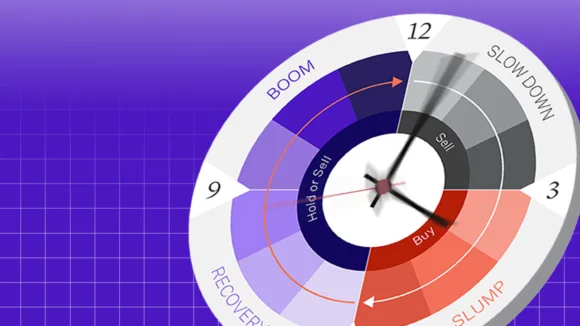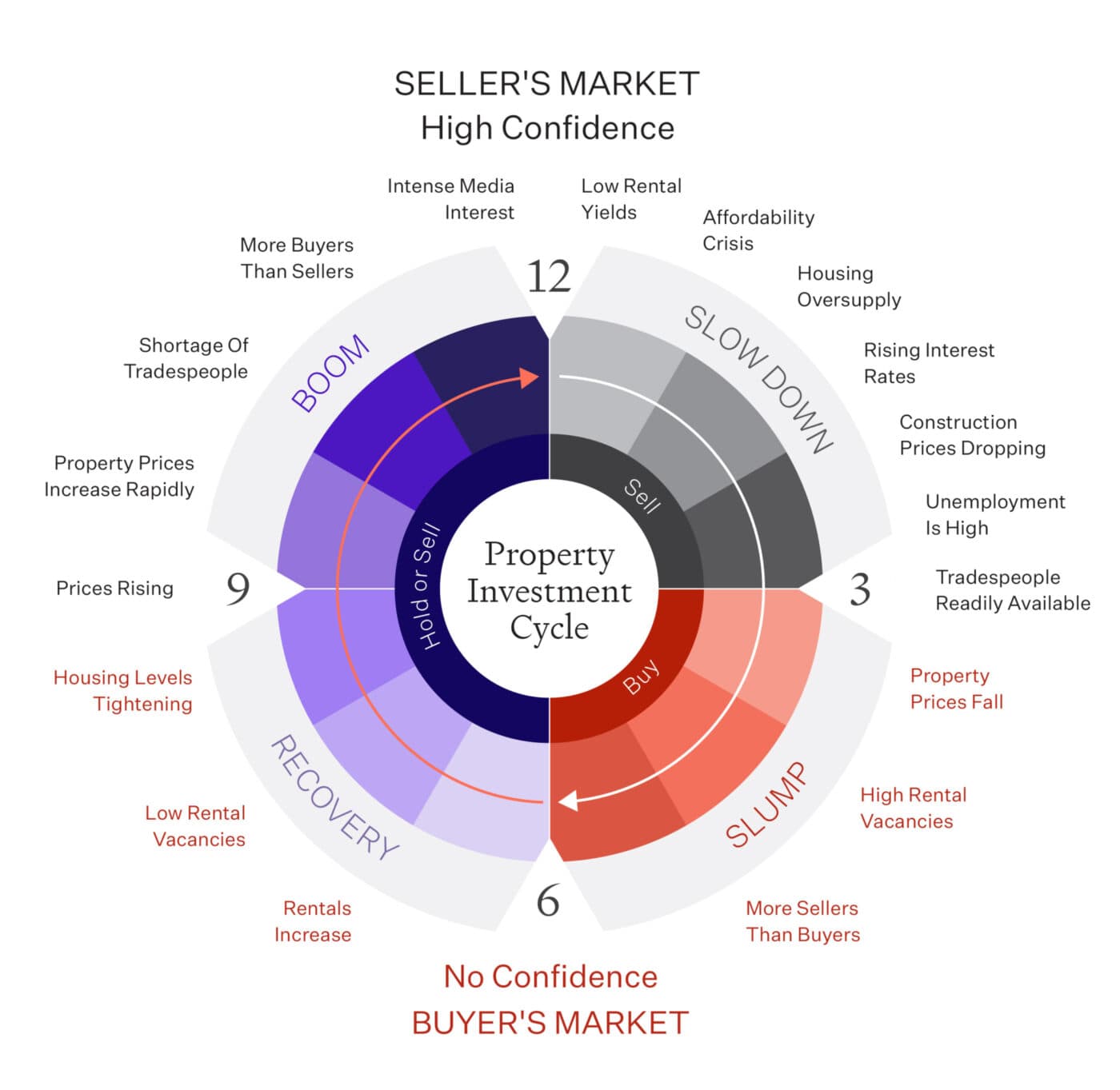
Property Investment
Property Investment
6 min read

Author: Andrew Nicol
Managing Director, 20+ Years' Experience Investing In Property, Author & Host
Reviewed by: Ed McKnight
Resident Economist, with a GradDipEcon and over five years at Opes Partners, is a trusted contributor to NZ Property Investor, Informed Investor, Stuff, Business Desk, and OneRoof.
The property market follows a very predictable pattern called the property cycle.
Some investors think about these cycles using the property clock.
Now, some people love the clock. Some don’t.
I use it often with investors I work with, and find it gives them 2 things:
Everyone knows that sometimes property prices increase. Sometimes they decrease. The property clock tells you where we are within these natural market cycles.
How does the property clock work?
12 o’clock is the peak of the market; 6 o’clock is the bottom of the market.
As the hand is going from 12 o’clock to 6 … property prices are on the way down.
But, when prices are rising, that’s the clock going from 6 o’clock back up to 12.
When the clock is at the top (between 10 – 2), that’s a seller’s market. When the clock is between 4 – 8, that’s a buyer’s market.

The clock has four phases: Boom, slow down, slump and recovery.
A couple of years ago, we were at 12 o’clock. We saw a rapid rise in house prices.
Then, after that, we got to 2 o’clock. This was when the Reserve Bank raised interest rates to try and cool down the market.
Then house prices started to fall and the media wrote articles like this. We were squarely at 4 o’clock.
Following that, developers stopped building and the number of consents declined too.
Around 6 o’clock is when house prices stop falling. We’ve just passed this point as a country right now.
Today, it’s 7 o’clock in the property market.
What needs to happen for us to get to 8 o’clock? We’ll need to see those interest rates come back down. That will give the market the boost it needs to head further into a recovery.
As the market recovers, some bad stuff will still happen. Unemployment will creep up, even though house prices are starting to pick up again.
What happens after that? Eventually property prices will boom again. The question is when?
You can use the property clock to identify whether it’s a buyers’ or sellers’ market.
A sellers’ market shows there’s high confidence in the market. Everyone wants in, and property prices are rising.
While that sounds great, you’re better off buying between 5 - 8 o’clock.
That’s where prices are at (or near) their lowest point.
But investing at that time is scary. Confidence is pretty low.
Even though it’s a buyers’ market many buyers will sit on their hands while experienced investors recognise the opportunity and look for deals.
It’s a time when there are loads of properties on the market to choose from and little competition.
On the other hand, you’re also better off selling at the upper end of the property cycle around 1 or 2 o’clock. Everyone’s buying and prices are high, so you’ll get a great price on your property.
I worked with Steve and Jess last week. They came to see me to put a property investment plan together.
Steve was confident about investing, but Jess was more on the fence.
At home, Steve had been trying to explain to Jess why he thought it was a good time to invest.
But Jess wasn’t as convinced, especially when you read articles on Stuff that talk about how our country is in recession.
Jess knows that unemployment is rising and interest rates are high. So she was thinking, “Steve, why do you want to spend our money on an investment property when everyone knows it’s not the right time to buy.”
As soon as I showed her the property clock, things clicked for her. She unfolded her arms, started being a bit more open … even her voice changed.
It was like a light bulb went on in her head.
Because the property clock showed her visually where we were in the market and what might happen next.
This gave Steve and (especially) Jess the confidence to invest in property.
The property clock isn’t perfect. It’s just a simple way to think about the market. There are 3 main drawbacks to this model.
This is an important one. Some people forget that property prices increase over time.
The property clock represents a cyclical pattern, not the same numbers going up and down.
Prices don’t go from $1 million at 12 o’clock then fall to $500k at 6 o’clock, then go back to $1 million, then down to $500k.
So, property prices don’t go around in a circle.
Every region in New Zealand is at a different stage of the property cycle, so they are at different times on the clock.
For example, Otago is at 9 o’clock right now. Property prices have increased 10% since the bottom of the market. They’ve fully recovered.
Whereas Bay Of Plenty house prices have only increased about 2% since the bottom. So, I’d put them more at the 6 o’clock mark.
So not every region is at the same part of the clock.
A full 12-hour cycle around the property clock can easily take 10 years.
But it doesn’t happen like clockwork.
You’ll fly through some parts of the property cycle. At other times you might stay at the same position on the property clock for years.
Generally, the boom phase of the clock will take about 6 years. The downturn phase might only take a 1.5 years and the recovery phase 2.5 years.
However, there have been times where the Gisborne property market stagnated at 7 o’clock for 12 years.
That means they got to 7 o’clock and didn’t move for over a decade.
So the property clock is a good way to visualise the market, but it’s not a perfect metaphor.
Right now, a lot of places in New Zealand will be around 7 o’clock. Some are a bit ahead, or behind – depending on the region.
But you are much more likely to find a good deal now than you will in 5 or 6 years, or 1 year ago.
The question investors should ask themselves is: “Which regions will start their boom phase first?”
After all, you don’t want to buy in a region that stays at 7 o’clock for the next decade.
My pick is that the major city centres will move into their boom phase first, while the regions will take longer to start moving through the clock.
What do you think? Let me know down in the comments section below.
Managing Director, 20+ Years' Experience Investing In Property, Author & Host
Andrew Nicol, Managing Director at Opes Partners, is a seasoned financial adviser and property investment expert with 20+ years of experience. With 40 investment properties, he hosts the Property Academy Podcast, co-authored 'Wealth Plan' with Ed Mcknight, and has helped 1,894 Kiwis achieve financial security through property investment.
This article is for your general information. It’s not financial advice. See here for details about our Financial Advice Provider Disclosure. So Opes isn’t telling you what to do with your own money.
We’ve made every effort to make sure the information is accurate. But we occasionally get the odd fact wrong. Make sure you do your own research or talk to a financial adviser before making any investment decisions.
You might like to use us or another financial adviser